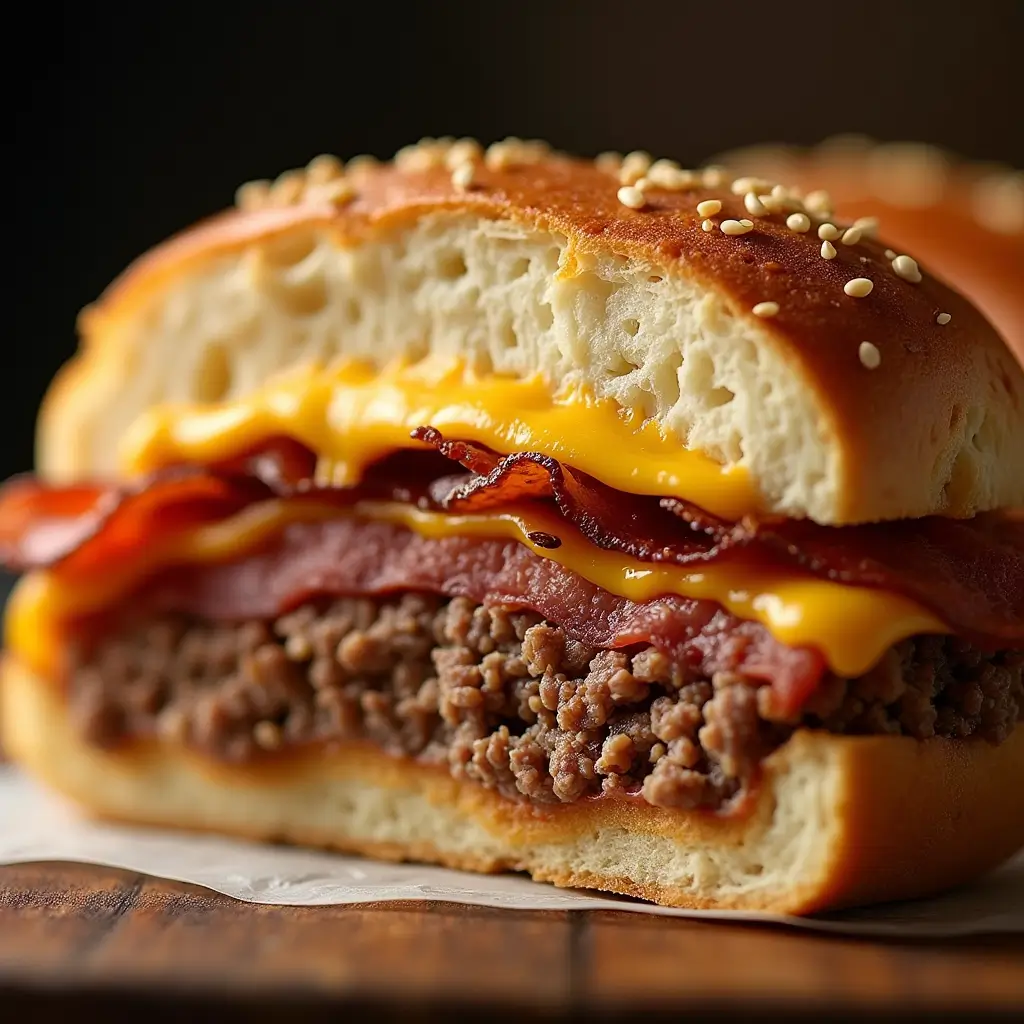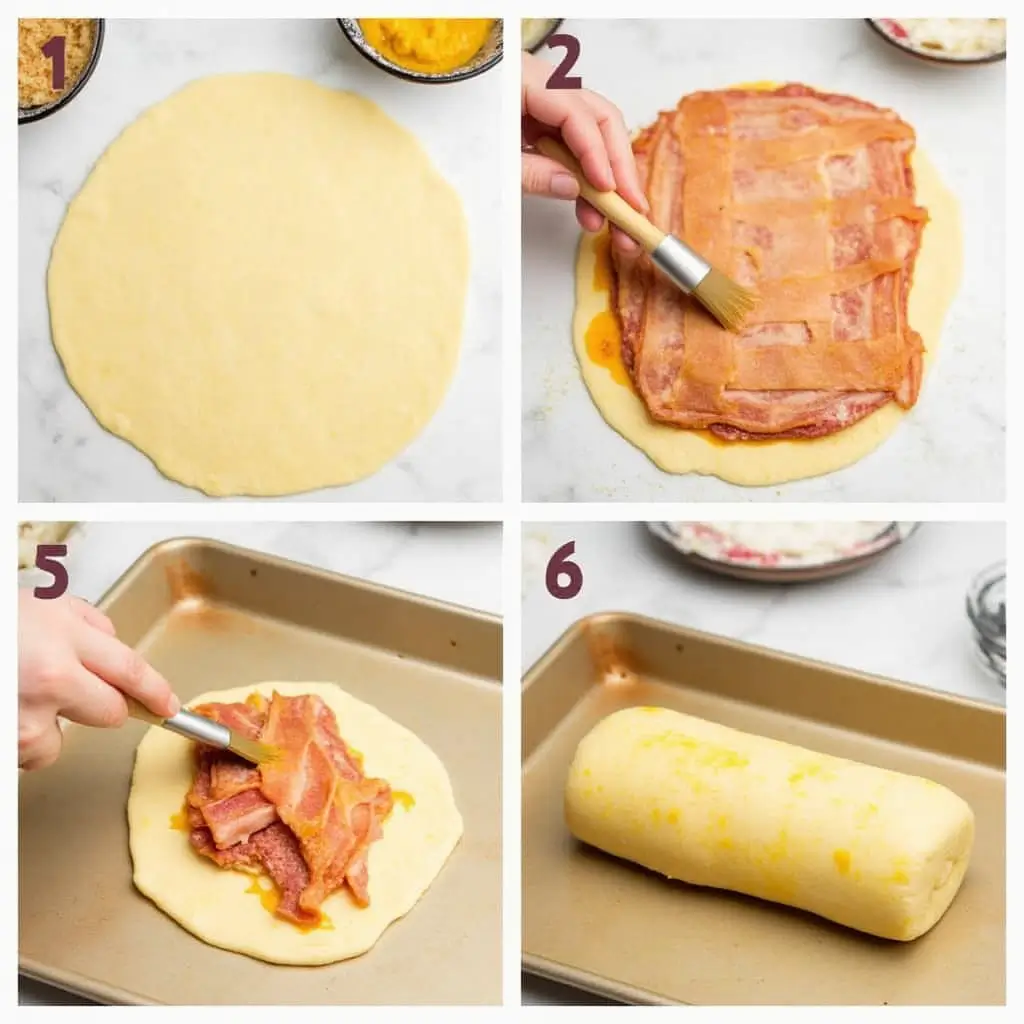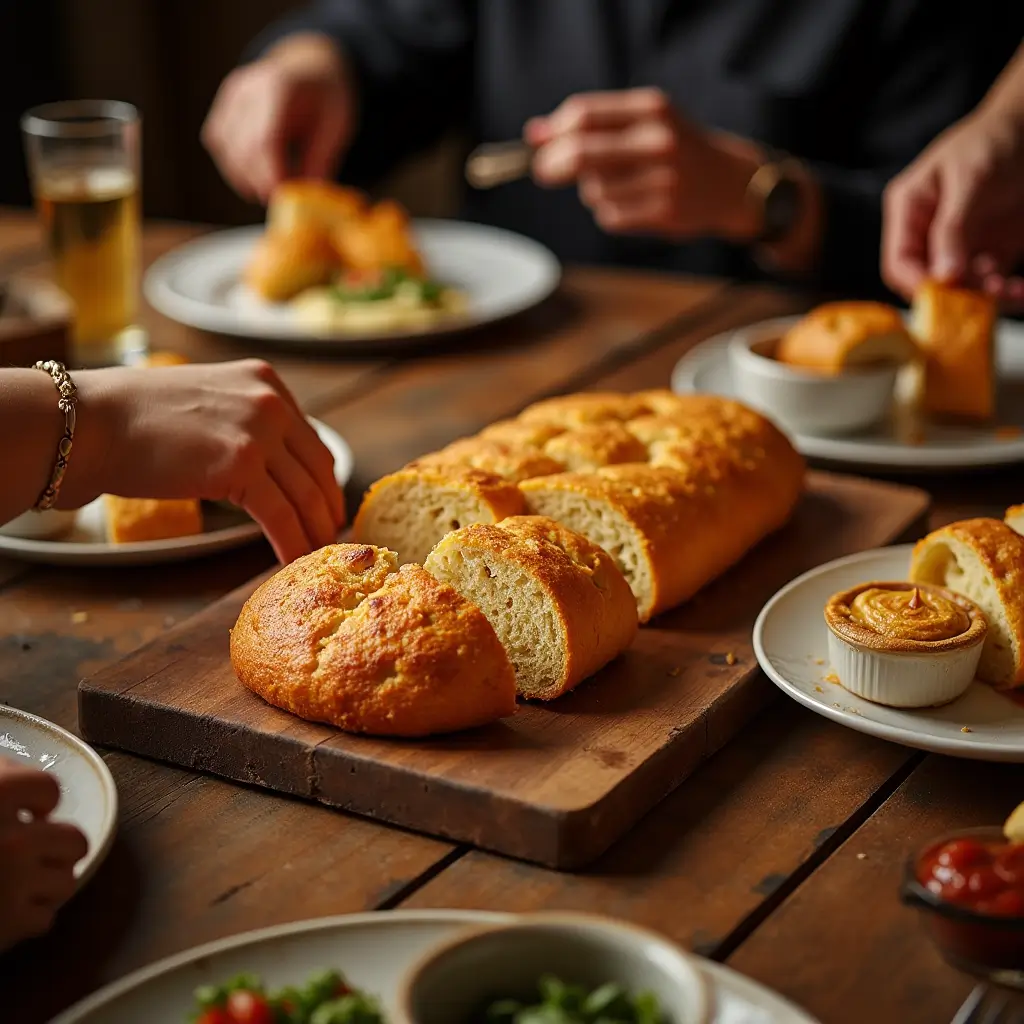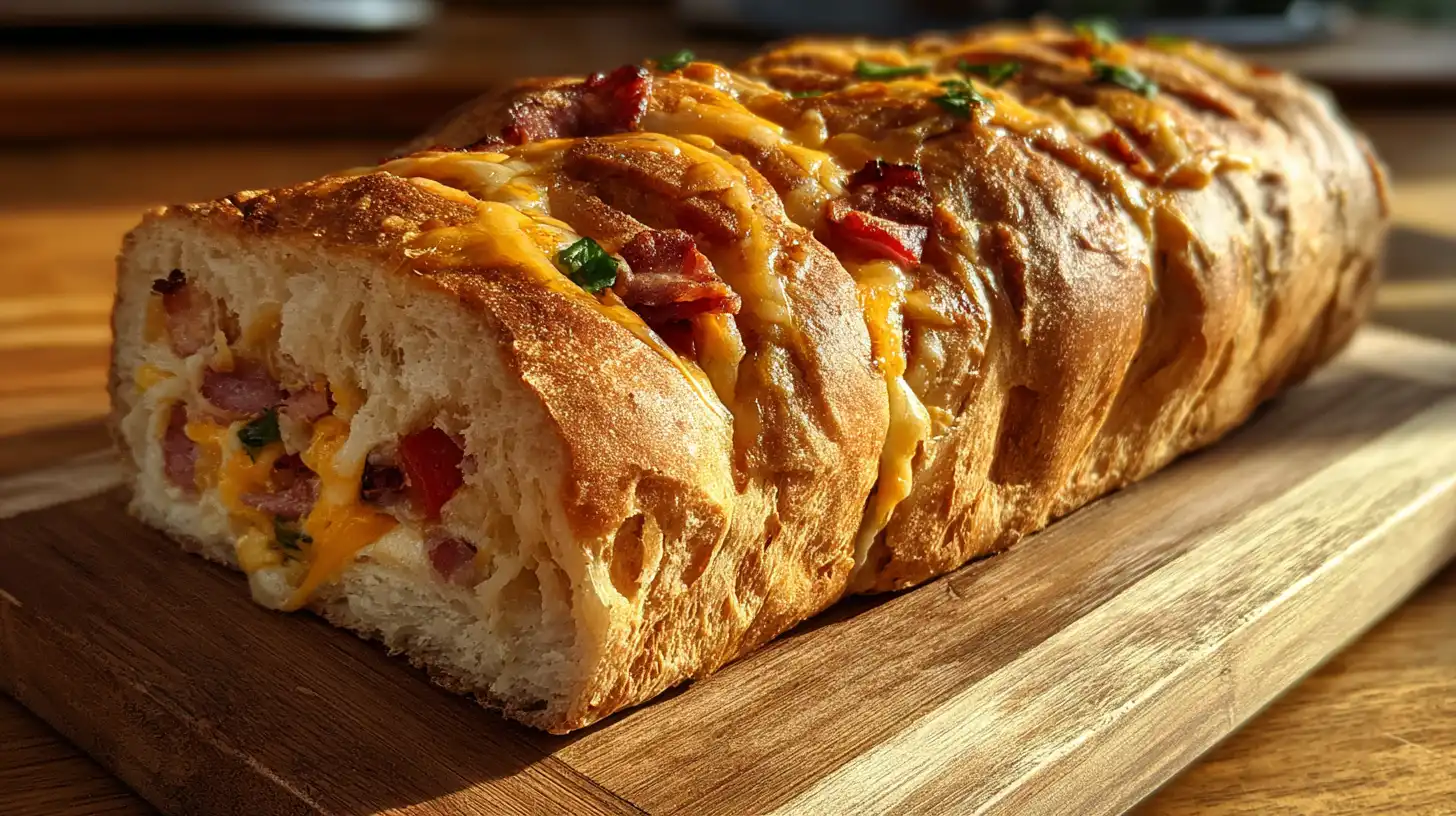Garbage bread recipe might sound like an odd name, but this savory, stuffed bread is anything but waste. It’s a delicious, budget-friendly way to turn leftovers and sourdough discard into a golden, rolled loaf packed with flavor. Whether you’re cleaning out the fridge or looking for a way to use up that last bit of deli meat, this recipe transforms scraps into something mouthwatering and satisfying.
What started as a humble solution to food waste has become a home-baking favorite across the U.S. Easy to customize, great for freezing, and perfect for meal prep—garbage bread deserves a spot in your weekly rotation.
Table of contents
Table of contents
What Is Garbage Bread?
Why Is It Called Garbage Bread?
The name “garbage bread” might sound off-putting at first, but it simply refers to a bread roll that’s stuffed with whatever leftovers you have in the fridge. It’s not made from trash—it’s made from treasure you’d otherwise toss: last night’s meatloaf, leftover roasted veggies, that single slice of cheddar, or even cold cuts nearing their expiration date.
It originated as a frugal meal hack, allowing families to avoid waste while creating something warm, filling, and absolutely delicious. In fact, it’s gained cult popularity in the baking community as a go-to way to use up sourdough discard or stretched doughs.
Today’s garbage bread recipe is far from the “junk” its name implies—it’s packed with flavor, texture, and personality, and it can be as clean or indulgent as you like.
The Misunderstood Reputation of Garbage Bread
What gives garbage bread its charm is how customizable it is. Think of it like a giant, rolled sandwich baked to golden perfection. The dough encases all your fillings, holding them together in a swirl of cheesy, savory goodness.
Many modern versions of garbage bread include healthy additions like:
- sautéed spinach or kale
- roasted sweet potatoes
- lean ground turkey or tofu
- and even fermented discard doughs
The garbage bread recipe is now a proud example of kitchen creativity—not a throwaway meal.
Looking for inspiration? Try this baked snack idea too: Air Fryer Cucumber Cheese Chips

Ingredients That Make Garbage Bread Delicious
Classic Garbage Bread Recipe Fillings
What makes a garbage bread recipe so special is how endlessly customizable it is. Traditionally, it’s made by rolling out pizza dough or discard-based dough and stuffing it with savory ingredients, then baking it until golden and bubbling.
Here are some classic (and irresistible) fillings used in most garbage bread recipes:
- Cooked ground beef or sausage
- Pepperoni or ham slices
- Mozzarella, cheddar, or provolone cheese
- Sautéed peppers and onions
- Marinara or pizza sauce
These ingredients layer beautifully, melt together during baking, and create a gooey, savory center that makes every slice a meal in itself.
Creative Add-Ins to Use Up Leftovers
One of the best things about a garbage bread recipe is that it gives leftovers new life. You can add almost anything that’s in your fridge—just make sure it’s not too wet, or it could make the dough soggy.
Try these creative, flavor-packed options:
| Leftover | Why It Works |
|---|---|
| Roasted vegetables | Adds texture and nutrients |
| Cooked chicken or turkey | Perfect for a lean protein option |
| Mashed potatoes | A hearty base layer |
| Spinach or kale (cooked) | Sneaks in greens and balances richness |
| Pesto or hummus | Adds bold, herby flavor |
Discover great ideas like these in our flavor-packed snack guide:
Pumpkin Seed Recipe for Weight Loss
Using Discard for the Dough Base
If you bake sourdough, you’ll love this tip: swap traditional dough with sourdough discard to make your garbage bread even more flavorful. The natural tang of discard adds depth, and it’s a smart way to avoid waste.
Mix discard with flour, water, salt, and a bit of olive oil for a soft, rollable dough that bakes beautifully. This twist gives your garbage bread recipe a subtle sourdough flavor and makes it easier on digestion.
Print
Garbage Bread Recipe – The Ultimate Guide to Using Discard & Boosting Flavor
- Total Time: 1 hour
- Yield: 1 loaf 1x
Description
A cheesy, crispy bread roll made with sourdough discard and packed with your favorite savory fillings.
Ingredients
- 1 cup sourdough discard
- 2 cups all-purpose flour
- 1 tsp baking powder
- ½ tsp salt
- ¼ cup olive oil
- 1 cup cooked meat (optional)
- 1 cup shredded cheese
- ½ cup cooked veggies
- ⅓ cup marinara or sauce of choice
Instructions
- Combine discard, flour, oil, salt, and baking powder to form dough.
- Let rest 20 mins, then roll into rectangle.
- Layer fillings evenly.
- Roll tightly and seal edges.
- Bake at 375°F for 30–35 mins.
- Cool slightly before slicing.
Notes
Freeze before or after baking. Use any fillings you like!
- Prep Time: 25 minutes
- Cook Time: 35 minutes
- Category: Snack
- Method: Baking
- Cuisine: American
Nutrition
- Serving Size: 1 slice
- Calories: 280
- Sugar: 2g
- Sodium: 450mg
- Fat: 14g
- Saturated Fat: 6g
- Unsaturated Fat: 7g
- Trans Fat: 0g
- Carbohydrates: 28g
- Fiber: 1g
- Protein: 10g
- Cholesterol: 25mg
Keywords: sourdough discard, cheesy bread, garbage bread, easy snack
How to Make the Perfect Garbage Bread Recipe
Step-by-Step Dough and Filling Preparation
Making the perfect garbage bread recipe starts with a flexible dough and bold, tasty fillings. If you’re using store-bought pizza dough, great! But if you’re working with sourdough discard, even better—it adds flavor and makes the recipe more gut-friendly.
For the Dough
If you’re using discard:
- 1 cup sourdough discard
- 2 cups all-purpose flour
- ½ tsp salt
- 1 tsp baking powder
- 2 tbsp olive oil
- ¼ cup water (adjust as needed)
Mix everything until smooth and elastic. Let it rest for 20–30 minutes so it’s easier to roll.
For the Filling
Here’s a balanced filling combo that works well in most garbage bread variations:
- 1 cup cooked meat (ground beef, sausage, or chicken)
- 1 cup shredded mozzarella
- ½ cup sautéed onions and bell peppers
- ⅓ cup marinara or pizza sauce
- Pinch of Italian seasoning
Make sure the filling is not too wet, or your dough will break or leak during baking.
Rolling, Stuffing, and Sealing Like a Pro
Once your dough is ready:
- Roll the dough on a lightly floured surface into a rectangle about ¼ inch thick.
- Spread your filling evenly, leaving a 1-inch border around the edges.
- Roll it up tightly from the long side like a jelly roll.
- Pinch the seams shut and place it seam-side down on a parchment-lined baking tray.
- Brush with olive oil or egg wash for a golden crust.
Optional: Sprinkle the top with sesame seeds, garlic powder, or grated Parmesan for extra flavor.
Let it rest while you preheat the oven. This small proofing time helps relax the dough and results in a more tender crumb.
Looking for another creative baking idea? Don’t miss this recipe:
Bariatric Seed Recipe for Weight Loss

Baking Instructions for Garbage Bread
What Temperature Should I Cook Garbage Bread At?
Most garbage bread recipes bake best at 375°F (190°C). This temperature allows the dough to cook through evenly while the outside develops a golden, crisp crust. For best results:
- Preheat your oven fully before baking
- Use the middle rack to ensure even heat
- Bake on a parchment-lined baking sheet or in a cast iron pan for a crispier base
If you’re using a thick filling or sourdough-based dough, you may want to drop the temperature slightly to 350°F and bake a little longer to avoid over-browning the crust before the inside is cooked.
How Long to Bake Garbage Bread
- Standard roll: 25 to 35 minutes
- Thicker stuffed loaf: 40 to 45 minutes
You’ll know it’s ready when:
- The crust is deep golden brown
- The seams are sealed and not doughy
- The bottom sounds hollow when tapped
For added precision, you can insert a thermometer into the center—it should read 190°F to 200°F when fully baked.
Extra Baking Tips for Perfect Results
- Brush the top with olive oil or an egg wash before baking for shine and color
- Vent the top with a few slits if your filling is especially moist to prevent soggy layers
- Let it rest 5–10 minutes before slicing to keep the fillings intact
Discover another warming recipe perfect for baking days:
Brazilian Mounjaro Recipe
Can You Freeze Garbage Bread for Later?
Can I Freeze Garbage Bread?
Absolutely. One of the best things about the garbage bread recipe is how freezer-friendly it is. Whether you want to store leftovers or prep several loaves in advance, freezing works like a charm.
Garbage bread holds up well in the freezer because it’s dense, tightly rolled, and filled with hearty ingredients that reheat beautifully. Just follow a few key tips to keep the crust crispy and the filling flavorful.
How to Freeze Garbage Bread (Cooked or Uncooked)
| Freezing Option | Steps |
|---|---|
| Freeze After Baking | Cool completely, wrap in foil, then plastic wrap or freezer bag. |
| Freeze Before Baking | Assemble and roll, wrap tightly in plastic wrap, then freeze on a tray. |
You can freeze cooked or uncooked garbage bread for up to 3 months.
Reheating Instructions
- From frozen (cooked): Bake at 350°F (175°C) for 25–30 minutes covered in foil
- From frozen (uncooked): Let thaw in fridge overnight, then bake as usual
Want to freeze single portions? Slice the baked bread, wrap individually, and pop slices into the toaster oven for fast, crispy leftovers.
Looking for more easy-to-store snacks? Don’t miss:
Natural Zepbound Drink Recipe
Creative Garbage Bread Variations
Vegetarian Garbage Bread Recipe Ideas
Don’t eat meat? No problem. A garbage bread recipe is incredibly flexible and easily adapted to vegetarian lifestyles. Try some of these satisfying veggie fillings:
- Sautéed spinach, garlic, and ricotta
- Roasted sweet potato, black beans, and cheddar
- Mushrooms, caramelized onions, and Swiss cheese
- Marinated tofu with pesto and mozzarella
These combos bring plenty of flavor and texture while keeping it plant-powered. Plus, adding sourdough discard to the dough increases both flavor and gut benefits.
Keto-Friendly and Low-Carb Modifications
Watching your carbs? Modify the dough or reduce the starchy fillings. For a low-carb garbage bread:
- Use almond flour or low-carb dough alternatives
- Fill with bacon, eggs, spinach, and cream cheese
- Skip sugary sauces—use pesto or herbed olive oil instead
- Make smaller, individual roll-ups for portion control
While traditional bread is carb-heavy, you can bake smaller rolls or experiment with protein-rich dough bases to keep things keto-ish.
High-Protein & Meal-Prep Friendly Stuffed Breads
Turn your garbage bread into a full meal with high-protein options:
- Grilled chicken, hummus, and chopped olives
- Ground turkey, quinoa, cheddar, and hot sauce
- Scrambled eggs, kale, and feta
Meal-prepping? Bake a few loaves ahead of time and freeze in slices for grab-and-go lunches or hearty snacks.
Looking for more bold, creative snacks? Don’t miss this one:
Air Fryer Cucumber Cheese Chips
Serving Ideas and Pairings
What to Serve with Garbage Bread
Your garbage bread recipe is already a star on its own, but pairing it with the right sides and dips can take it to the next level—whether you’re prepping a casual family dinner or party appetizer tray.
Great Side Pairings:
- Simple salads: Arugula with lemon vinaigrette or kale Caesar
- Hearty soups: Tomato basil, butternut squash, or chicken noodle
- Veggie sticks: Carrots, cucumbers, and celery with hummus
These help balance out the richness of the bread while keeping things wholesome and fresh.
Best Dips for Garbage Bread Slices
Garbage bread loves a good dip. Try these crowd-pleasers:
| Dip | Flavor Profile |
|---|---|
| Marinara sauce | Classic pizza-style flavor |
| Garlic butter | Rich and savory |
| Pesto | Herby and bright |
| Spicy ranch or aioli | Creamy with a kick |
| Cheese sauce | For ultra-indulgent bites |
Slice the bread into 1-inch pieces and serve warm with one or two dips for a fun party platter.
Drink Pairings for a Full Experience
Balance the flavors of a savory garbage bread recipe with refreshing drinks like:
- Sparkling water with lemon
- Light red wine or sangria
- Iced green tea with mint
- Homemade kombucha
- Or even a detox tonic like this:
Natural Zepbound Drink Recipe
Whether you’re entertaining or feeding a crowd, these pairings make garbage bread a complete, well-rounded meal.n foil and freeze for up to 2 months. Just thaw overnight before reheating!

FAQs About the Garbage Bread Recipe
Why is it called garbage bread?
Despite the name, garbage bread doesn’t involve actual garbage. It’s called that because it’s traditionally made by using up whatever leftovers or “scraps” you have in the fridge—like meats, cheeses, and sauces. The goal is to minimize food waste while creating a delicious, rolled bread packed with flavor. A true garbage bread recipe is resourceful, not trashy!
What temperature should I cook garbage bread at?
Bake your garbage bread recipe at 375°F (190°C). This allows the dough to bake through evenly while creating a golden, crisp crust. If you’ve added lots of fillings, you can lower the temp to 350°F and increase the time slightly to ensure it’s cooked all the way through.
Can I freeze garbage bread?
Yes, garbage bread freezes beautifully. Whether baked or unbaked, just wrap it tightly in foil and plastic wrap, then store it in the freezer for up to 3 months. When ready to eat, reheat from frozen or thaw overnight and bake as usual.
How to add discard to a bread recipe?
To use sourdough discard in a garbage bread recipe, replace part of the flour and water with discard (usually 1 cup). Adjust the dough’s hydration slightly to keep it workable. Discard adds a subtle tang and improves flavor without requiring a rise.
What happens if you use discard to make bread?
Using discard adds a slight sour flavor and makes the dough denser, which is perfect for a rustic garbage bread recipe. It won’t rise like active starter, but it enhances taste and digestibility while reducing food waste.
Can I use active starter in a discard recipe?
Yes, you can swap in an active sourdough starter in place of discard. Just use the same amount. Active starter may provide more rise, so reduce additional leavening agents slightly. Both work well in a garbage bread recipe depending on your goal—flavor or fermentation.
follow kamala Recipes on Facebook for daily wellness inspiration and natural remedies.
Conclusion
Garbage bread is more than just a clever way to use leftovers—it’s a delicious, customizable, and budget-friendly meal that’s perfect for any occasion. Whether you’re craving a classic cheeseburger version, a smoky BBQ chicken twist, or even a breakfast-style loaf, this stuffed bread adapts to whatever you have on hand.
With its crispy crust, gooey cheese, and flavorful fillings, garbage bread is a hit for family dinners, parties, or meal prep. Plus, with endless ingredient possibilities, you’ll never get bored of making it!
Now that you know how to prepare, customize, and store it, why not try making your own version today? Get creative, experiment with flavors, and enjoy every bite!

